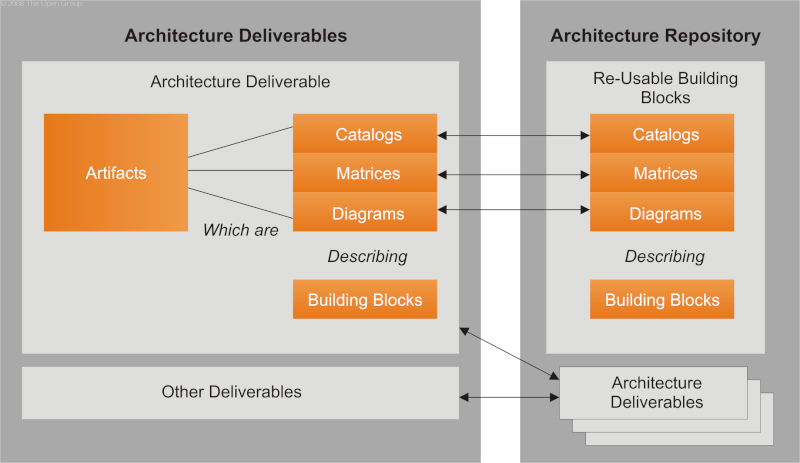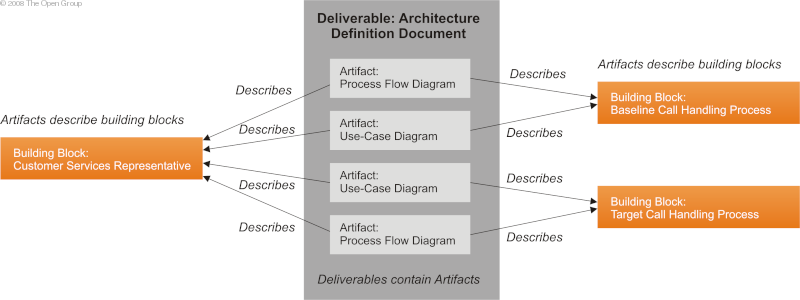Architects executing the ADM will produce a number of outputs as a result of their efforts, such as process flows,
architectural requirements, project plans, project compliance assessments, etc. The TOGAF Architecture Content
Framework (see Content Framework Introduction) provides a structural model for architectural
content that allows major work products to be consistently defined, structured, and presented.
The Architecture Content Framework uses the following three categories to describe the type of architectural work
product within the context of use:
-
A deliverable is a work product that is contractually specified and in turn formally reviewed, agreed, and
signed off by the stakeholders. Deliverables represent the output of projects and those deliverables that are in
documentation form will typically be archived at completion of a project, or transitioned into an Architecture
Repository as a reference model, standard, or snapshot of the Architecture Landscape at a point in time.
-
An artifact is a more granular architectural work product that describes an architecture from a specific
viewpoint. Examples include a network diagram, a server specification, a use-case specification, a list of
architectural requirements, and a business interaction matrix. Artifacts are generally classified as catalogs
(lists of things), matrices (showing relationships between things), and diagrams (pictures of things). An
architectural deliverable may contain many artifacts and artifacts will form the content of the Architecture
Repository.
-
A building block represents a (potentially re-usable) component of business, IT, or architectural capability
that can be combined with other building blocks to deliver architectures and solutions.
Building blocks can be defined at various levels of detail, depending on what stage of architecture development
has been reached. For instance, at an early stage, a building block can simply consist of a name or an outline
description. Later on, a building block may be decomposed into multiple supporting building blocks and may be
accompanied by a full specification. Building blocks can relate to "architectures" or "solutions".
-
Architecture Building Blocks (ABBs) typically describe required capability and shape the
specification of Solution Building Blocks (SBBs). For example, a customer services capability may be
required within an enterprise, supported by many SBBs, such as processes, data, and application software.
-
Solution Building Blocks (SBBs) represent components that will be used to implement the required
capability. For example, a network is a building block that can be described through complementary
artifacts and then put to use to realize solutions for the enterprise.
The relationships between deliverables, artifacts, and building blocks are shown in Relationships between Deliverables, Artifacts and Building Blocks.

Figure: Relationships between Deliverables, Artifacts, and Building
Blocks
For example, an Architecture Definition Document is a deliverable that documents an architecture description.
This document will contain a number of complementary artifacts that are views of the building blocks relevant
to the architecture. For example, a process flow diagram (an artifact) may be created to describe the target
call handling process (a building block). This artifact may also describe other building blocks, such as the
actors involved in the process (e.g., a Customer Services Representative). An example of the relationships
between deliverables, artifacts, and building blocks is illustrated in Example - Architecture Definition Document.

Figure: Example - Architecture Definition Document
|

